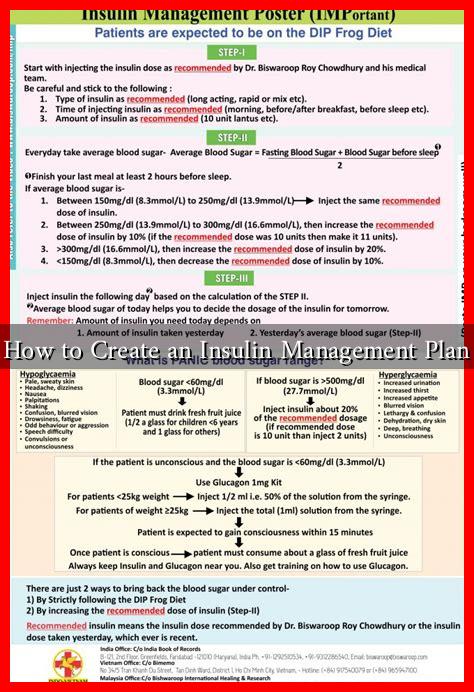-
Table of Contents
- How to Create an Insulin Management Plan
- Understanding Insulin and Its Role in Diabetes
- Key Components of an Insulin Management Plan
- Steps to Create Your Insulin Management Plan
- 1. Consult with Healthcare Professionals
- 2. Set Clear Goals
- 3. Choose the Right Insulin Regimen
- 4. Develop a Carbohydrate Counting System
- 5. Monitor and Adjust
- Case Study: Sarah’s Journey with Insulin Management
- Tips for Success
- Conclusion
How to Create an Insulin Management Plan
Managing diabetes effectively requires a comprehensive approach, and one of the most critical components is an insulin management plan. This plan helps individuals with diabetes regulate their blood sugar levels, minimize complications, and improve their overall quality of life. In this article, we will explore how to create an effective insulin management plan, including essential components, tips for success, and real-life examples.
Understanding Insulin and Its Role in Diabetes
Insulin is a hormone produced by the pancreas that allows cells to absorb glucose from the bloodstream. For individuals with Type 1 diabetes, the body does not produce insulin, while those with Type 2 diabetes may not use insulin effectively. According to the American Diabetes Association, approximately 34.2 million Americans have diabetes, highlighting the importance of effective insulin management.
Key Components of an Insulin Management Plan
Creating an insulin management plan involves several key components:
- Blood Sugar Monitoring: Regularly checking blood glucose levels is crucial. This can be done using a glucometer or continuous glucose monitor (CGM).
- Insulin Types and Dosing: Understanding the different types of insulin (rapid-acting, long-acting, etc.) and determining the appropriate dosages is essential.
- Carbohydrate Counting: Learning to count carbohydrates helps in adjusting insulin doses based on food intake.
- Exercise and Activity Levels: Physical activity affects blood sugar levels, so it’s important to incorporate exercise into the management plan.
- Emergency Plan: Having a plan for hypoglycemia (low blood sugar) or hyperglycemia (high blood sugar) is vital for safety.
Steps to Create Your Insulin Management Plan
Follow these steps to develop a personalized insulin management plan:
1. Consult with Healthcare Professionals
Start by consulting with your healthcare team, including an endocrinologist, diabetes educator, and dietitian. They can provide valuable insights tailored to your specific needs.
2. Set Clear Goals
Establish realistic and measurable goals for your blood sugar levels. For example, aim for an A1C level below 7% or target specific blood glucose ranges before and after meals.
3. Choose the Right Insulin Regimen
Based on your lifestyle and preferences, your healthcare provider may recommend:
- Multiple daily injections (MDI) of insulin
- Insulin pump therapy
- Basal-bolus insulin regimen
4. Develop a Carbohydrate Counting System
Learn how to count carbohydrates in your meals. This knowledge will help you adjust your insulin doses accordingly. Tools like food diaries or apps can assist in tracking your intake.
5. Monitor and Adjust
Regularly monitor your blood sugar levels and adjust your insulin doses as needed. Keep a log of your readings, food intake, and physical activity to identify patterns.
Case Study: Sarah’s Journey with Insulin Management
Sarah, a 28-year-old woman diagnosed with Type 1 diabetes, struggled to maintain her blood sugar levels. After working with her healthcare team, she developed an insulin management plan that included:
- Using a continuous glucose monitor to track her levels in real-time.
- Implementing a carbohydrate counting system that allowed her to enjoy her favorite foods without fear.
- Incorporating regular exercise into her routine, which helped her lower her insulin needs.
As a result, Sarah achieved her A1C goal of 6.5% within six months, significantly improving her quality of life.
Tips for Success
To ensure the effectiveness of your insulin management plan, consider the following tips:
- Stay educated about diabetes management through reputable sources like the American Diabetes Association.
- Communicate openly with your healthcare team about any challenges you face.
- Join support groups or online communities for motivation and shared experiences.
Conclusion
Creating an insulin management plan is a vital step in managing diabetes effectively. By understanding the role of insulin, setting clear goals, and regularly monitoring your blood sugar levels, you can take control of your health. Remember that this plan is not static; it should evolve as your lifestyle and needs change. With the right support and resources, you can lead a fulfilling life while managing your diabetes.

